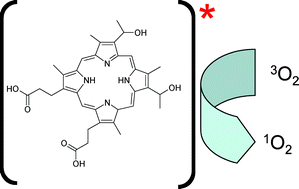Singlet oxygen quantum yields of potential porphyrin-based photosensitisers for photodynamic therapy†
Abstract
The singlet oxygen formation quantum yield (ΦΔ) for solutions of the di-cation, free-base and metallated forms of hematoporphyrin derivative (HpD), hematoporphyrin IX (Hp9) and a boronated protoporphyrin (BOPP) are reported using the method of direct detection of the characteristic phosphorescence following polychromatic excitation. Values of ΦΔ for the free-base form of all the


 Please wait while we load your content...
Please wait while we load your content...